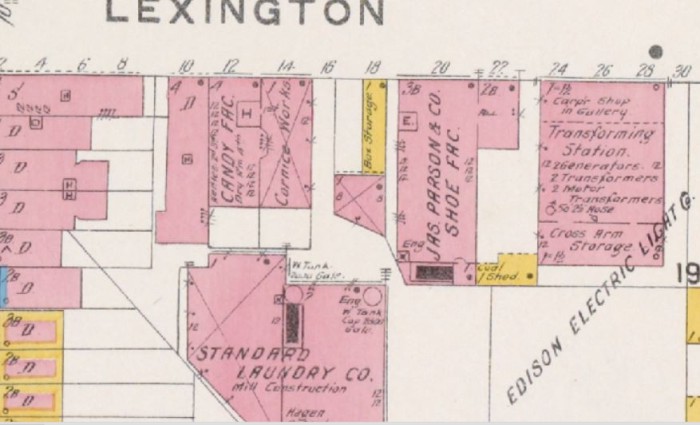Building of the Day: 20-22 Lexington Avenue
Brooklyn, one building at a time. Name: Former James Parson & Co. factory, now loft apartments and the Callidus Guild Address: 20-22 Lexington Avenue Cross Streets: Classon and Grand Avenues Neighborhood: Clinton Hill Year Built: perhaps 1887, with later alterations. Architectural Style: 19th century brick factory Architect: Maybe DeMeuron & Smith Landmarked: No The story:…


Brooklyn, one building at a time.
Name: Former James Parson & Co. factory, now loft apartments and the Callidus Guild
Address: 20-22 Lexington Avenue
Cross Streets: Classon and Grand Avenues
Neighborhood: Clinton Hill
Year Built: perhaps 1887, with later alterations.
Architectural Style: 19th century brick factory
Architect: Maybe DeMeuron & Smith
Landmarked: No
The story: Manhattan has, or should I more correctly say, HAD, different areas of midtown that became synonymous for different industries. The 20’s west of 6th Avenue used to be the Flower District, between 35th and 40th Street west of 7th Ave. was the Garment District, and east of there, between the same blocks, was the Millinery and Trims District. There was the Meat Packing District, Tin Pan Alley, where the composers and musical publishers were concentrated, and of course, the Theater District. Brooklyn wasn’t quite as compact, especially after it became a part of New York City, but even here, we had certain areas that had a concentration of certain industries. Wallabout was a food and candy manufacturing district, for example. This part of Clinton Hill was our own shoe manufacturing district.
Between the 1880s and until just after World War II, we were producing vast amounts of shoes here in Brooklyn. The factories ran the gamut of shoes and boot styles and sizes. There were companies that only made men’s shoes, or women’s or children’s footwear. Some made high quality shoes and boots, others made cheaper models. Those shoes were sold in retail stores and catalogues all over the country; a perusal of company names brings up advertising from all across America.
A few months ago, I wrote up the building just across the street from today’s entry, number 13-23 Lexington Avenue. Before it became apartments, it was built as a shoe factory for the Pincus and Tobias Shoe Company. This building, number 20-22 Lexington was home to one of their competitors; James Parsons & Co. Shoes.
The “Shoe Retailer,” a footwear industry trade magazine, noted in 1905, when James Parsons died, that his had been one of the city’s best known shoe manufacturers. James Parson was born in England, and learned the cobbler’s trade, and then factory shoemaking there. He came to the United States in 1952, and began working for the Whitehouse Shoe Company in Manhattan. In 1865, he branched out on his own, and opened his own factory. He moved that factory to Brooklyn in 1884.
According to the Real Estate Record and Builder’s Guide, in 1887, architects DeMeuron & Smith of Manhattan were contracted to design a four story brick factory, 100 x 40, on the corner of Lexington and Grand for the James Parson & Co. Shoe Company. The mention was not very specific as to exact location.
This building is 56×90, and may have been an expansion to a second location. Then again, maybe not, and this was DeMeuron & Smith’s actual building. Buildings often change between the announcement and the actuality of building. According to a 1904 map, this was definitely James Parsons & Co. Shoes. The address also appears in several news stories.
Mr. Parsons’ obituary in the trade magazine mentions that he was partnered with Thomas W. Kirkham, Samuel W. Bennett and George P. Davidson, the first two being his sons-in-law. The firm must have changed names before Parsons’ passing, as it was referred to as Parson & Bennett Shoes in a newspaper article in 1894. Apparently one employee at the plant hit another employee in the head with shoemaker’s pinchers, seriously injuring him. Mr. Bennett was trying to get him out of jail, and back to work, but the judge wasn’t having it.
James Parson was one of those businessmen who came to the factory every day, in spite of being 75 years old and getting rather unwell and infirm. He was at the factory, as usual, the day before he died of a stroke at his breakfast table. The company was to be continued by his partners. I could not find out when they left Brooklyn, or went out of business.
Most of the shoe companies in Brooklyn lasted until the end of World War II. Not only did shoe manufacture ring start to move overseas, within the next few years, the city also tore down the Lexington Avenue Elevated train, which helped make this area so conducive to factories. Without the train, the commute was much longer for workers, and the area started to die out for industry in general.
If this was the same four story factory designed by in 1887, much of its upper stories were lost at some point in the 20th century. In 1976, it belonged to the North American Motors Company, and was used as a garage. It was converted to apartments sometime in the 1980s. Today, it’s a great looking home to tenants, and at least one arts company.
Since 2007, the building has been the headquarters for Callidus Guild, a collective of painters, sculptors, artisans, plasterers, gilders and applied art makers. They are well known in the decorative arts industry for their bespoke surfaces for interior and architectural projects, creating “fashions for walls.” Beautiful work in a great space.
(Photograph: S.Spellen)









What's Your Take? Leave a Comment